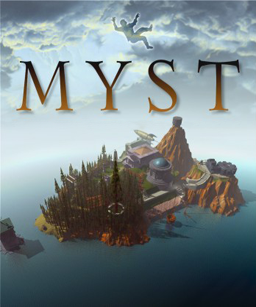
Myst is a graphic adventure/puzzle video game designed by the Miller brothers, Robyn and Rand. It was developed by Cyan, Inc., published by Broderbund, and initially released for the Macintosh in 1993. In the game, the player's character travels via a special book to the island of Myst. From there, solving puzzles allows the player to travel to four other worlds which reveal the backstory of the game's characters, one of which the player must eventually choose to aid.

Riven is a puzzle adventure video game. It is the sequel to Myst and second in the Myst series of games. Developed by Cyan Worlds, it was initially published by Red Orb Entertainment, a division of Broderbund. Riven was distributed on five compact discs and released on October 31, 1997, in North America; it was later released on a single DVD-ROM on August 17, 1998, with improved audio and a fourteen-minute "making-of" video. In addition to the PC versions, Riven has been ported to several other platforms.

Uru: Ages Beyond Myst is an adventure video game developed by Cyan Worlds and published by Ubisoft. Released in 2003, the title is the fourth game in the Myst canon. Departing from previous games of the franchise, Uru takes place in the modern era and allows players to customize their onscreen avatars. Players use their avatars to explore the abandoned city of an ancient race known as the D'ni, uncover story clues and solve puzzles.

Cyan, Inc., also known as Cyan Worlds, Inc., is an American video game developer. Founded as Cyan Productions by brothers Rand and Robyn Miller in 1987, the company is best known as the creator of the Myst series. The company is located in Mead, Washington, just outside Spokane.

Myst III: Exile is the third title in the Myst series of graphic adventure puzzle video games. While the preceding games in the series, Myst and Riven, were produced by Cyan Worlds and published by Brøderbund, Exile was developed by Presto Studios and published by Ubi Soft. The game was released on four compact discs for both Mac OS and Microsoft Windows on May 8, 2001; versions for the Xbox and PlayStation 2 were released in late 2002. A single-disc DVD version was later released for Windows and Mac OS.

Myst IV: Revelation is an adventure video game, the fourth installment in the Myst series, developed and published by Ubisoft. Like Myst III: Exile, Revelation combines pre-rendered graphics with digital video, but also features real-time 3D effects for added realism. The plot of Revelation follows up on plot details from the original Myst. The player is summoned by Atrus, a man who creates links to other worlds known as Ages by writing special linking books. Almost twenty years earlier, Atrus' two sons nearly destroyed all of his books and were imprisoned; Atrus now wishes to see if his sons' imprisonment has reformed them. The player travels to each brother's prison, in an attempt to recover Atrus' daughter Yeesha from the brothers' plot.

Rand Miller is a C.E.O. and co-founder of Cyan Worlds. He and brother Robyn Miller became famous due to the success of their computer game Myst, which remained the all-time best-selling computer game from its release in 1993 until that record was surpassed by The Sims nearly a decade later. Rand also worked on the game's sequel, Riven, and later reprised his role as protagonist Atrus in Myst III: Exile, realMyst, Uru, Myst IV: Revelation, and Myst V: End of Ages. He also co-authored Myst novels The Book of Atrus, The Book of Ti'ana, and The Book of D'ni.

Pyst is an adventure computer game released in October 1996. It was created as a parody of the highly successful adventure game Myst. Pyst was written by Peter Bergman, a co-founder of the Firesign Theatre, and was published by Parroty Interactive, with Bergman, Stallone, Inc. as co-publisher. Mindscape began distributing the game on August 20, 1997. The parody features full motion video of actor John Goodman as "King Mattruss", the ruler of "Pyst Island". Versions of the game were produced for both the Windows PC and Apple Macintosh operating systems.
Myst is a franchise centered on a series of adventure video games. The first game in the series, Myst, was released in 1993 by brothers Rand and Robyn Miller and their video game company Cyan, Inc. The first sequel to Myst, Riven, was released in 1997 and was followed by three more direct sequels: Myst III: Exile in 2001, Myst IV: Revelation in 2004, and Myst V: End of Ages in 2005. A spinoff featuring a multiplayer component, Uru: Ages Beyond Myst, was released in 2003 and followed by two expansion packs.

Myst V: End of Ages is a 2005 adventure video game, the fifth installment in the Myst series. The game was developed by Cyan Worlds, published by Ubisoft, and released for Macintosh and Windows PC platforms in September 2005. As in previous games in the series, End of Ages's gameplay consists of navigating worlds known as "Ages" via the use of special books and items which act as portals.
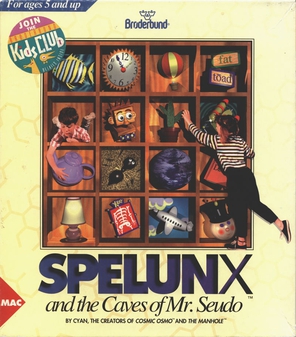
Spelunx and the Caves of Mr. Seudo is an educational computer game intended for young children developed by Cyan in 1991.

Robyn Charles Miller is the co-founder of Cyan Worlds with brother Rand Miller. He served as co-designer of the popular computer game Myst, which held the title of best-selling computer game from its release in 1993 until the release of The Sims seven years later. He also co-directed and co-lead designed the sequel to Myst, Riven, which was the best-selling computer game of its year of release, 1997. Miller composed and performed the soundtracks to both games. He also acted in Myst, portraying one of the antagonists, Sirrus. He co-wrote the first Myst novel, The Book of Atrus.
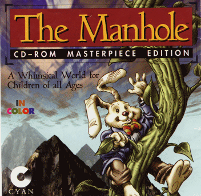
The Manhole is an adventure video game in which the player opens a manhole and reveals a gigantic beanstalk, leading to fantastic worlds.
StrataVision 3D is a comprehensive 3D computer graphics software package developed by Strata. Features include primitives-based modeling with texturising, keyframe animation, raytrace and later radiosity rendering under the name of Raydiosity.

Amber: Journeys Beyond is an American computer game released in 1996 for Apple Macintosh computers and Windows 95. It is the only game produced by Hue Forest Entertainment, founded by Frank and Susan Wimmer.
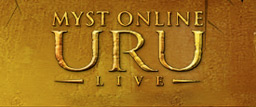
Myst Online: Uru Live is an open source massively multiplayer online adventure game developed by Cyan Worlds. The game is the multiplayer component to the 2003 video game Uru: Ages Beyond Myst. Like Uru, Myst Online takes place in 2000s New Mexico, where an ancient civilization known as the D'ni once thrived. The D'ni had the ability to create portals to other worlds or Ages by writing descriptive books of the Age. Players uncover clues and solve puzzles together; plot developments were added via episodic content updates.
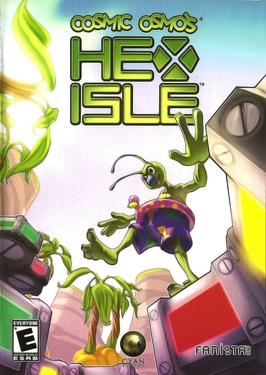
Cosmic Osmo's Hex Isle is a 3D puzzle/adventure game for Mac and Windows by Cyan Worlds and Fanista released on November 30, 2007. It is a sequel to the adventure game Cosmic Osmo and the Worlds Beyond the Mackerel, also by Cyan Worlds. Osmo has been incarcerated because of his extreme laziness. The aim is to help Osmo escape from his prison by touching a set of coloured hexagonal targets on each level.
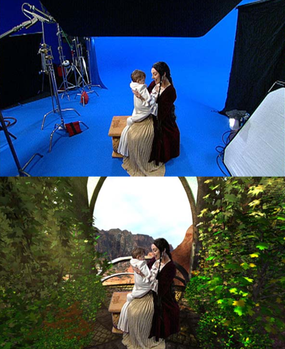
The Myst series of adventure computer games deals with the events following the player's discovery of a mysterious book describing an island known as Myst. The book is no ordinary volume; it is a linking book, which serves as a portal to the world it describes. The player is transported to Myst Island and must unravel the world's puzzles in order to return home. Myst was a commercial and critical success upon release and spawned four sequels—Riven, Exile, Revelation and End of Ages— as well as several spinoffs and adaptations.
Obduction is an adventure video game developed by Cyan Worlds. Obduction is considered a spiritual successor to Cyan's previous adventure games, Myst and Riven. In the game, the player finds their character transported to strange alien worlds but with human elements within the settings. The player must explore and solve puzzles to figure out how to return home.
CyanWorlds.com Engine is a real-time 3D game engine originally called Headspin and developed by Headspin Technologies in 1997 and later by Cyan Worlds to power the next generation of real time 3D Myst series games such as URU: Complete Chronicles and Myst V: End of Ages.
















